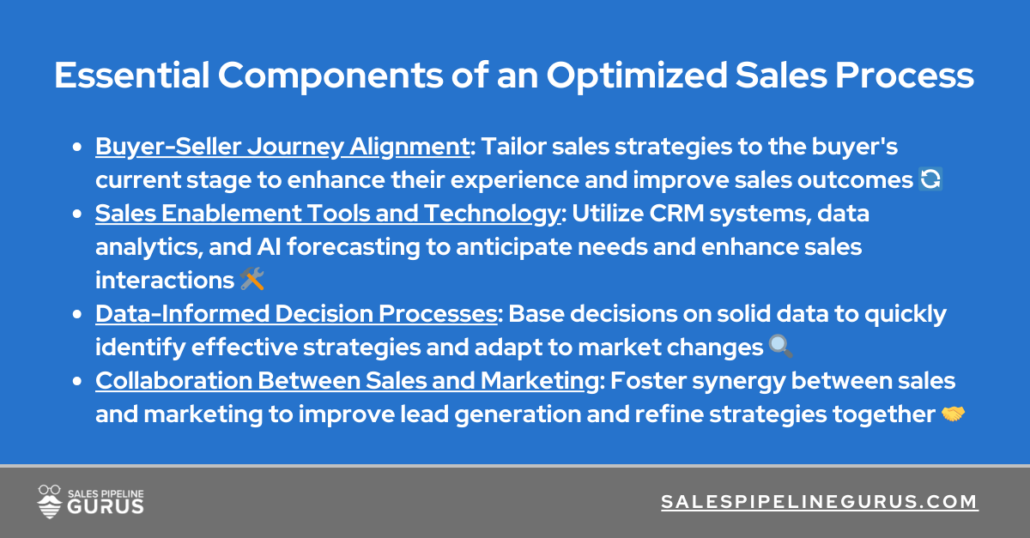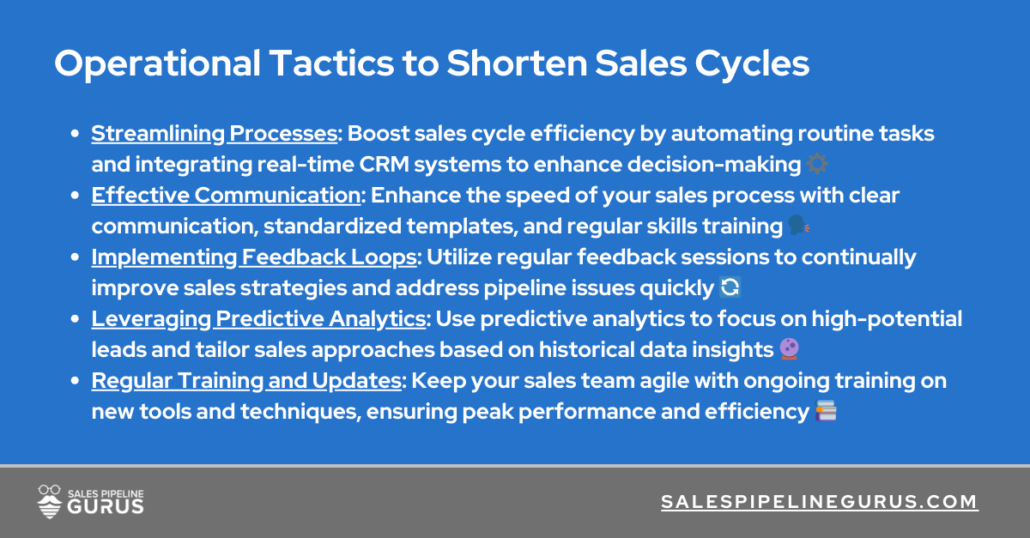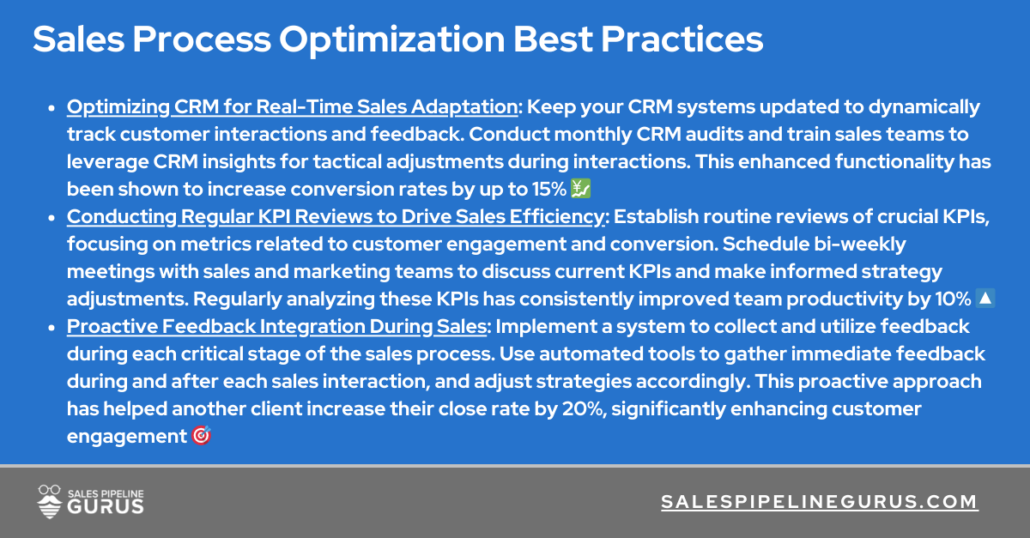Sales Training in 2024: The Ultimate Guide

Navigating the B2B sales landscape in 2024 demands more than just traditional selling skills. It requires a mastery of digital engagement and an adaptive approach to the evolving buyer’s journey. Consequently, this transformation isn’t just on the horizon. It’s here, reshaping how sales training helps teams adapt, build relationships, and close deals.
Through my experience in sales and marketing, I’ve directly observed the challenges and opportunities of this new era. This is what inspired me to compile this essential guide on sales training for the modern sales professional.
This guide provides a blueprint to upskill your sales team by mixing innovative techniques with core selling principles. So, let’s embark on this journey together, equipping your team to thrive in the dynamic landscape of 2024.
Here, we’ll cover:
- Understanding Sales Training Needs
- The Best Sales Methodologies to Learn in 2024
- The Role of Training in Overcoming Common Sales Challenges
- Choosing the Right Training Program
- Choosing the Right Training Techniques for Adoption
- Implementing Training for Maximum Impact
- Leveraging Technology in Training
- Tracking and Measuring Training Success
- Conclusion and Next Steps
1. Understanding Sales Training Needs
In B2B sales, identifying your team’s specific training needs is the starting point for transformation. Sales professionals, from new hires to managers, quickly adapt to training programs tailored to their unique challenges and goals.
Identifying Training Needs
The first step is conducting a thorough assessment of your sales team’s skills, knowledge gaps, and performance metrics. Achieve this through performance reviews, analyzing sales metrics, and direct team feedback. Importantly, distinguishing between individual contributors and sales leaders is crucial. Contributors need hands-on techniques; leaders benefit from strategic and leadership training.
Tailored Training Programs
Once you’ve identified the specific needs of your team, the next step is to match these needs with the appropriate training programs. For individual contributors, focus on programs that enhance practical skills such as prospecting, lead qualifying, and closing techniques. Sales leaders will find value in advanced courses that review sales coaching skills, forecasting, team management, and relationship-building. However, you don’t need a sales coaching certification to lead effectively.
Continuous Learning and Development
In the realm of sales, learning is an ongoing journey. The most successful sales teams are those that embrace learning and apply sales coaching best practices in their culture. This includes regular training sessions, workshops, and even self-directed learning opportunities. To this end, encourage your team to stay current on the latest sales trends, tools, and sales coaching tips to boost their performance and keep them motivated.
Leveraging Technology
In today’s digital age, leveraging technology for effective sales coaching in training programs is non-negotiable. From online courses and webinars to virtual reality simulations and AI-driven coaching tools, technology can significantly enhance the learning experience. As a result, it allows busy sales professionals to learn on their own time at their own pace.
Knowing what your sales team needs to improve is more than just filling in knowledge gaps. This will equip them to succeed in a competitive market. Ultimately, by understanding these needs and customizing your training programs, you can improve sales performance and accelerate business growth.
Pro Tip: Review your team’s sales training needs regularly to keep up with market changes and internal growth. This will help ensure that your team always aligns with your goals.
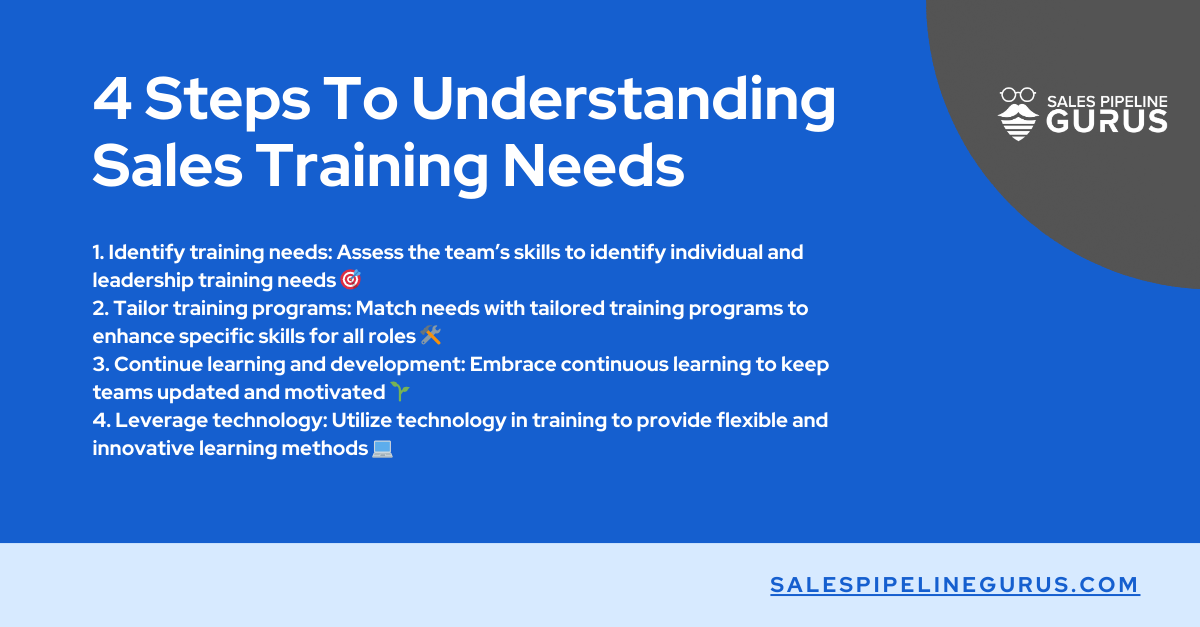
2. The Best Sales Methodologies to Learn in 2024
The right sales methodology can transform your sales process. It can provide a strategic framework that guides your team through the complexities of engaging and converting prospects. Below, we explore the top 11 sales methodologies, their fit for various sales environments, and their pros and cons.
1. SPIN Selling: Navigating Complex B2B Sales
Introduction: SPIN Selling is a question-led approach that uncovers the explicit needs of customers. This approach is deal for complex B2B environments.
- Application: Spin Selling is best suited for intricate B2B sales that require deep understanding of customer needs.
- Pros:
- This methodology has a proven, research-based framework.
- Focuses on customer needs, enhancing engagement.
- Streamlines the sales process through effective lead qualification.
- Cons:
- Requires intensive training.
- Misapplying this methodology can create the impression of manipulative.
- Not ideal for simple, quick transactions.
Conclusion: SPIN Selling is a good strategy for teams in complicated sales situations. It helps them understand customer needs better and have better conversations.
2. Solution Selling: Customizing Success in B2B Sales
Introduction: Solution Selling emphasizes tailored solutions to customer problems, positioning the salesperson as a trusted advisor.
- Application: Ideal for B2B, technology sales, and environments needing customization.
- Pros:
- Builds strong, trust-based relationships.
- Enhances the potential for upselling or cross-selling.
- Tailors solutions to precise customer challenges.
- Cons:
- The discovery phase may prolong the sales cycle.
- High demand for skilled sales professionals.
- Limited application in simple or transactional sales.
Conclusion: Solution Selling is perfect for complex sales settings, requiring detailed customization to effectively address customer issues.
3. Value Selling: Elevating Sales with Clear ROI
Introduction: Value Selling shows how a product meets customer goals with clear, measurable benefits.
- Application: Suitable for high-stakes B2B sales and competitive markets.
- Pros:
- Highlights customer benefits, supporting premium pricing.
- Differentiates offerings by focusing on value.
- Enhances customer satisfaction and loyalty.
- Cons:
- Requires deep product and market knowledge.
- May lengthen the sales cycle due its detailed analyzing.
- Requires precise, often complex data analyzing.
Conclusion: Value Selling excels in environments where clear ROI demonstration is critical, providing a competitive edge in saturated markets.
4. Challenger Selling: Transforming B2B Sales Conversations
Introduction: Challenger Selling involves educating customers with insights that challenge their thinking, ideal for differentiating offerings in competitive markets.
- Application: Effective in homogenous and competitive industries.
- Pros:
- Provides unique insights, enhancing customer engagement.
- Ideal for navigating complex B2B interactions.
- Shifts focus to business value and outcomes.
- Cons: Demands comprehensive knowledge of the customer’s business.
- May not resonate with all customers.
- Requires high-level communication skills.
Conclusion: Challenger Selling transforms the sales approach by fostering a deeper engagement through insightful challenges to conventional customer views.
5. Sandler Selling: A Revolutionary Approach to Sales
Introduction: Sandler Selling emphasizes honest dialogue and mutual respect over direct selling, improving the buyer-seller relationship.
- Application: Versatile across industries, particularly in industries that prioritize long-term relationships.
- Pros:
- Encourages an open and pressure-free dialogue.
- Builds lasting, trust-based customer relationships.
- Enhances salesperson satisfaction and effectiveness.
- Cons:
- Necessitates a significant shift in sales strategy.
- May extend the sales cycle because of detailed needs assessment and iterative discussions.
- May not align well with quick, transactional sales models.
Conclusion: Sandler Selling suits environments that value trust and lasting relationships. It offers a respectful, consultative approach to sales.
6. Consultative Selling: Deepen Customer Connections
Introduction: Consultative Selling builds trust by treating sales as advisory, focusing deeply on understanding and meeting customer needs.
- Application: Effective in complex sales environments requiring custom solutions.
- Pros:
- Deepens customer relationships.
- Tailors advice and solutions to specific customer needs.
- Enhances customer satisfaction through personalized service.
- Cons:
- Requires highly skilled sales personnel.
- Can lead to longer sales cycles.
- Less suitable for simpler and lower-cost products.
Conclusion: Consultative Selling is perfect for companies that aim to differentiate themselves through superior customer service and customized solutions. Which leads to increased loyalty and satisfaction.
7. Inbound Selling: Aligning Sales with Customer Journeys
Introduction: Inbound Selling aligns sales strategies with modern inbound marketing techniques. It uses personalized content to engage customers early in their buying journey.
- Application: Best for businesses integrated with digital marketing and content strategies.
- Pros:
- Matches modern buying behaviors with personalized engagement.
- Increases efficiency by attracting more qualified leads.
- Enhances overall customer experience and satisfaction.
- Cons:
- Depends heavily on high-quality content creation.
- Longer to show results compared to direct methods.
- Requires close integration between sales and marketing teams.
Conclusion: Inbound Selling leverages content to attract customers. Which makes it ideal for sectors where buyers prefer to research extensively before purchasing. This results in more effective and efficient sales processes.
8. Conceptual Selling: Aligning Vision with Value
Introduction: Conceptual Selling emphasizes aligning sales efforts with the customer’s strategic visions and goals. This enhances the relevance and impact of solutions offered.
- Application: Suited for B2B sales and complex decision-making environments.
- Pros:
- Ensures sales efforts resonate with customer’s strategic goals.
- Fosters a deeper understanding of customer needs.
- Strengthens the advisory role of the sales team.
- Cons:
- Requires strong questioning and listening skills.
- Comprehensive preparation needs may extend the sales cycle.
- Less effective for straightforward or commodity products.
Conclusion: Conceptual Selling excels in environments where aligning with the customer’s broader business strategies is crucial. It offers a tailored approach that significantly enhances customer experience.
9. CustomerCentric Selling: Empowering Through Understanding
Introduction: CustomerCentric Selling focuses on engaging the customer actively in the sales process. This method tailors discussions and solutions to their specific needs and challenges.
- Application: Works well in B2B and intricate sales processes.
- Pros:
- Increases customer engagement and commitment.
- Builds trust and loyalty through personalized interactions.
- Enhances the probability of sales success with tailored solutions.
- Cons:
- Demands extensive training for sales teams.
- Potentially lengthens the sales cycle.
- Relies heavily on customer’s willingness to engage.
Conclusion: CustomerCentric Selling shifts the focus from selling to understanding. This method is especially effective for building long-term relationships and enhancing customer satisfaction through customized solutions.
10. MEDDIC: Precision in Complex Sales
Introduction: MEDDIC is a structured sales methodology that focuses on a detailed qualification process. This method enhances deal closure rates in complex, high-value B2B sales.
- Application: Ideal for complex sales involving multiple decision-makers.
- Pros:
- Enhances deal qualification and sales forecasting accuracy.
- Encourages a strategic, analytical approach to sales.
- Ensures alignment between solutions and customer business goals.
- Cons:
- Requires rigorous training and strict procedural adherence.
- May slow down the sales cycle, especially in early adoption.
- Less practical for simpler sales scenarios.
Conclusion: MEDDIC is a powerful tool for organizations navigating complex sales landscapes. This method offers a meticulous approach that aligns with strategic business outcomes and maximizes deal potential.
11. Wing-It Selling: The Unstructured Approach
Introduction: Wing-It Selling represents an informal approach that relies on the salesperson’s instincts and adaptability, bypassing structured processes for spontaneity.
- Application: Suitable for less complex sales and environments valuing speed.
- Pros:
- Offers flexibility and quick adaptation to customer responses.
- Simplifies the sales process by focusing on speed.
- Personal for each customer interaction.
- Cons:
- Can lead to inconsistent sales results and forecasting difficulties.
- May overlook deeper customer needs and solutions.
- Risks appearing unprofessional without a structured approach.
Conclusion: Wing-It Selling suits environments that value individual skill and quick thinking over formal process. This method offers speed and personalization but at the risk of reduced consistency and depth in customer engagement.
Selecting the right sales methodology hinges on aligning with your sales goals, process nature, and product features. Furthermore, blending multiple methodologies often yields the best outcomes when guided by a well-versed sales expert. This approach precisely tailors strategies to fit your unique needs.

3. The Role of Training in Overcoming Common Sales Challenges
Today, individual reps face a plethora of challenges that can hinder their performance and, ultimately, the company’s bottom line. From navigating digital transformations to personalizing sales approaches for increasingly informed customers, the complexity of sales has significantly increased. Therefore, effective sales training equips teams with essential knowledge, skills, and strategies to tackle challenges head-on.
Adapting to Digital Transformations
As the sales environment becomes more digital, sales teams must learn to leverage new technologies. Sales professionals can enhance their skills by undergoing training on digital tools and platforms. Consequently, this will help them effectively engage customers and simplify sales processes.
Personalizing Sales Approaches
Modern buyers expect personalized interactions. Sales training teaches representatives to gather and use customer data to customize their pitches. This leads to higher engagement and conversion rates.
Shortening Sales Cycles
Lengthy sales cycles can drain resources. Sales teams can improve lead qualification and move prospects through the sales funnel more efficiently with proper training.
Enhancing Product Knowledge
Deep product knowledge is more crucial than ever. Sales training programs can provide comprehensive insights into the product or service, enabling sales professionals to answer customer questions confidently and accurately.
Improving Communication Skills
Effective communication is at the heart of successful sales. Training can help sales representatives refine their communication skills, ensuring they can convey value propositions clearly and persuasively.
Navigating Competitive Markets
In competitive industries, standing out is key. Sales training can offer strategies for differentiating products or services. This helps teams to emphasize unique selling points and capture customer interest. Additionally, sales and marketing coaching conversations can provide better alignment and results.
In conclusion, investing in sales training goes beyond improving individual performance. It also involves assisting sales teams in overcoming the common challenges present in today’s sales environment. Ultimately, this investment can lead to more efficient sales processes, higher customer satisfaction, and ultimately, increased revenue.
Pro Tip: Use role-play exercises that simulate real sales scenarios. This boosts your team’s confidence and problem-solving abilities.
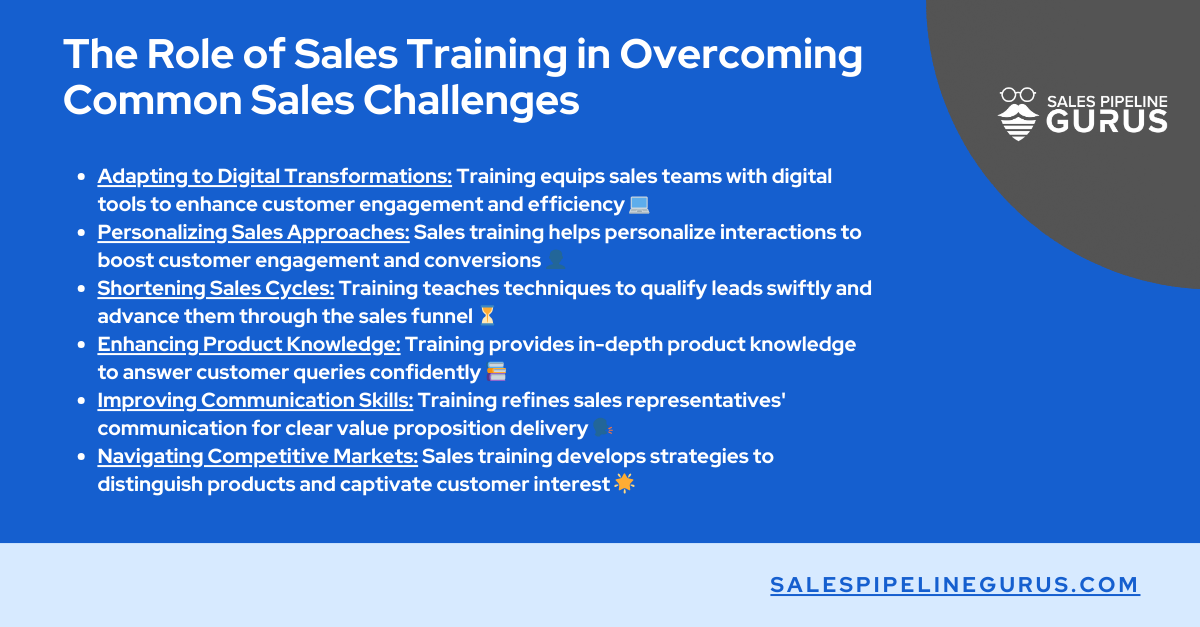
4. Choosing the Right Training Program
With many sales training programs available, choosing the right one can seem daunting. The right choice is essential for addressing specific team challenges and aligning with your company’s goals. So, here’s what to consider when selecting a sales training program:
Identify Specific Needs
Before exploring options, assess your team’s strengths and weaknesses. Are there gaps in digital sales skills, or do they need better strategies for lead qualification? Additionally, what about coaching sales leaders?
Alignment with Sales Strategy
Ensure the training program complements your overall sales strategy. If you’re focusing on inbound selling, for example, choose a program that emphasizes digital engagement and content marketing.
Methodology Fit
Consider which sales methodologies align with your market, product, and sales cycle. A program that offers training in a methodology proven to work in your industry can be more beneficial.
Customized Options
The best training programs offer customized sales coaching techniques to address your team’s unique challenges and objectives. Also, look for programs that offer tailored sales manager coaching to specifically fit the developmental needs of your leaders.
Trainer Expertise
Research the trainers’ backgrounds to identify the best sales coach. A professional sales coach with a proven track record can provide invaluable insights and practical advice.
Interactive and Practical Learning
Choose programs that offer interactive learning experiences, like role-playing or live coaching sessions. Practical learning can help your team apply new skills more effectively.
Follow-up and Reinforcement
Training shouldn’t end with the sessions. Look for programs that include follow-up resources, ongoing coaching in sales, or tools for reinforcing the learning.
Feedback from Peers
Seek recommendations from peers in your industry. Learning about their experiences with different programs can provide useful insights.
In conclusion, selecting the right sales coaching program is a strategic investment in your team’s development and future success. Focus on your specific needs, align with your sales strategy, and ensure that learning is applicable. You can choose a program that not only enhances your team’s skills but also contributes to achieving your sales goals. Ultimately, the most successful sales coaches will blend these sales methodologies and tailor them to fit your sales strategy.
Pro Tip: Seek programs that offer post-training support. This includes follow-up sessions or access to digital learning resources, to maximize long-term benefits.
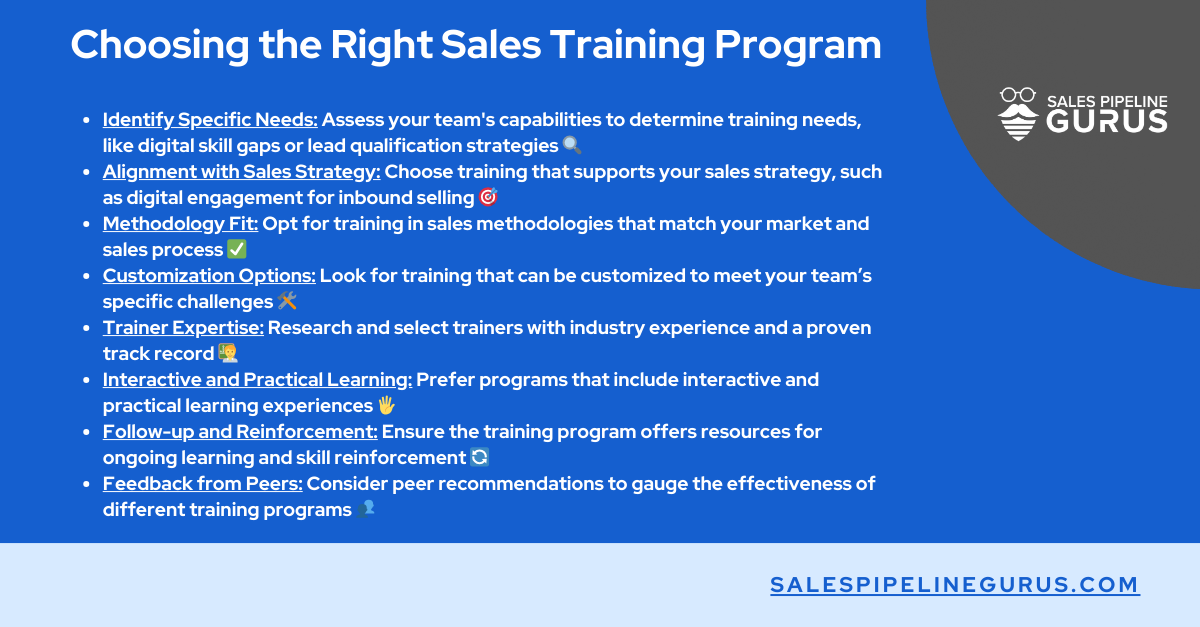
5. Choosing the Right Training Techniques for Adoption
Understanding the intricacies of prospecting and deal-closure are pivotal for sales success. Often, a fear of these stages indicates a need for enhanced training. Consequently, when sales targets become elusive mirages, revamping your training approach might be the key to turning mirages into oases.
The following sales training methods are proven to accelerate growth, efficiency, and elevate your sales team’s performance.
Sales Onboarding
Prepares new hires by immersing them in company culture, product portfolios, and sales operation models to accelerate their path to productivity.
Real-time Sales Coaching
Facilitates immediate, hands-on guidance and performance feedback directly on the sales floor or during sales activities, fostering a culture of rapid learning and adaptation.
Interactive Strategy Workshops
Concentrates on elevating sales tactics through dynamic sessions that dissect market trends, product insights, and advanced selling techniques with a participatory approach.
Deal Review Sessions
Utilizes in-depth discussions of actual sales cases to sharpen strategic thinking and collaborative problem-solving skills, aiming to improve deal-closing strategies.
Visual Learning Modules
Employs cutting-edge visual aids like video tutorials, infographics, and interactive simulations to make complex sales concepts more accessible and engaging.
Peer Mentorship Initiative
Pairs budding sales talent with seasoned veterans for a transfer of tacit knowledge, leveraging real-world experiences to nurture sales expertise.
Targeted Skill Development Programs
Offers curated off-the-floor training designed to hone specific competencies, such as negotiation tactics, digital selling skills, or CRM mastery, in a focused classroom setting.
Sales Playbooks
Provides comprehensive reference guides that encapsulate essential sales knowledge, from value propositions to objection handling, ensuring consistent execution across the salesforce.
Industry Insight Forums
Facilitates exchange of best practices and innovative sales strategies through expert-led seminars, focusing on overcoming common sales barriers and leveraging competitive intelligence.
Field Immersion Training
Delivers an end-to-end sales process experience under the mentorship of sales leaders, from lead generation to deal closure, emphasizing practical application of learned strategies.
To conclude, selecting the right training techniques is crucial for your sales team’s success. Focus on methods that align with your strategy and meet specific needs. Consequently, choose techniques like onboarding, coaching, and workshops to boost performance and achieve targets.
Pro Tip: Use microlearning for quicker, more effective training. Break big ideas into small pieces to help your team learn and remember better, fitting training into their busy schedules.

6. Implementing Training for Maximum Impact
Successfully implementing a sales training program goes beyond just selecting the right one. To ensure the training has a lasting impact and truly enhances your team’s performance, follow these strategies:
Secure Buy-in from Sales Team
Begin by explaining the benefits and objectives of the training. Emphasize the importance of coaching a sales team effectively. Highlight how it will address their challenges and contribute to their success.
Integrate Training with Daily Activities
Make the training relevant by integrating it with the team’s daily sales activities. Applying new skills in real-world scenarios helps reinforce learning.
Provide Tools and Resources
Equip your sales team with the tools and resources outlined in your sales coaching plan to apply what they’ve learned. This could include access to sales enablement software, templates, guides, or action plans.
Establish Metrics for Success
Define clear metrics to evaluate the effectiveness of sales performance coaching and training. This could include improvements in sales conversion rates, shorter sales cycles, or increased customer satisfaction.
Create a Supportive Learning Environment
Encourage an environment where team members feel comfortable sharing insights and challenges. Peer learning can be an effective complement to formal training.
Schedule Regular Follow-ups and Coaching
Reinforce training concepts with regular follow-up sessions and personal sales coaching strategies. This helps address any gaps and ensures continuous improvement.
Celebrate Successes
Recognize and celebrate improvements and successes. This not only motivates the team but also demonstrates the value of the training investment.
In conclusion, effective sales training needs careful planning and ongoing commitment. Make training relevant, supported, and routine for the team. Ultimately, this maximizes investment impact, boosting skills, efficiency, and motivation.
Pro Tip: Use the training you receive in your daily sales activities and meetings. This will help create a culture of continuous improvement and encourage practical application.

7. Leveraging Technology in Training
In today’s digital age, technology plays a crucial role in enhancing the effectiveness of sales training. Here’s how organizations can leverage technology to maximize the impact of their sales training efforts:
Online Learning Platforms
Utilize online platforms that enhance flexible, self-paced learning and facilitate sales team coaching. These platforms offer courses on various sales methodologies and specific skills, enabling teams to learn at their convenience.
Virtual Reality (VR) and Simulations
Implement VR and simulation tools to create realistic sales scenarios. This immersive technology lets salespeople practice pitches and handle objections. They improve their sales technique in a risk-free environment.
Mobile Learning Apps
Take advantage of mobile apps to deliver bite-sized learning content. Sales teams access training materials, videos, and quizzes on-the-go, easily fitting learning into busy schedules.
Sales Enablement Tools
Integrate sales enablement tools that provide real-time guidance and support. These tools provide prompts, scripts, and relevant content during calls, reinforcing training in live sales situations.
Collaboration Platforms
Use collaboration tools to foster peer learning and share best practices. Use platforms like Slack or Microsoft Teams to discuss sales strategies, share successes, and provide feedback.
Data Analytics and AI
Leverage data analytics and AI to personalize training content based on individual performance and needs. Analytics can identify areas where salespeople excel or need improvement, allowing for more targeted training.
Feedback and Coaching Software
Implement software that facilitates ongoing feedback and coaching. This technology can track sales calls, analyze performance, and provide actionable insights for improvement.
To conclude, embracing technology in sales training enhances access and engagement. It also allows for personalized training experiences. By leveraging the right tools and platforms, organizations equip their sales teams with necessary skills. In essence, these skills are crucial for thriving in a competitive digital marketplace.
Pro Tip: Use CRM analytics to tailor training topics for your team according to their specific needs. This way, they can acquire skills that are directly applicable to their roles.

8. Tracking and Measuring Training Success
To make sure your sales training program keeps improving, it’s important to track and measure its success regularly. Here are key strategies to effectively evaluate your sales training program:
Set Clear, Measurable Objectives
Before the training begins, define what success looks like. Objectives might include increasing close rates, reducing the sales cycle length, or improving customer satisfaction scores.
Use Sales Metrics and KPIs
Monitor important metrics like sales revenue, quota achievement, deal size, and lead conversion rates. Comparing these metrics before and after training can provide insights into the program’s impact.
Leverage Sales Analytics Tools
Utilize sales analytics tools to gather data on sales performance and behaviors. These tools can help identify trends, strengths, and areas for improvement post-training.
Gather Feedback from Participants
Collect feedback from the sales team about the training experience, material relevance, and fit. Surveys and interviews can reveal how well the training met their needs and expectations.
Assess Behavioral Changes
Beyond quantitative metrics, observe and assess changes in sales behaviors and practices. Look for increased adoption of new strategies, techniques, and tools introduced during the training.
Review Customer Feedback and Satisfaction
Monitor changes in customer feedback and satisfaction levels. Positive shifts can indicate that sales training has improved customer interactions and outcomes.
Calculate Return on Investment
Identify the value of the training by comparing the cost to the increase in revenue. This calculation helps justify the investment in sales training.
Plan for Continuous Improvement
Sales training is an ongoing process. Use the insights gained from tracking and measurement to refine and enhance future training programs. This ensures they remain aligned with sales goals and market demands.
In conclusion, methodically tracking and measuring your sales training program’s success is essential. Ensure it delivers tangible benefits and boosts long-term growth.
Pro Tip: Beyond sales metrics, gauge training effectiveness by monitoring team morale and customer feedback. This provides a holistic view of impact.

Conclusion and Next Steps
In today’s fast-changing B2B sales environment, tailored training and the right tools aren’t just beneficial—they’re essential. Navigating the complex B2B buyer’s landscape and shifting to digital sales requires strategic training. Ultimately, this approach boosts your team’s capabilities and propels your business to new heights.
Now, we’ve outlined different methods and strategies to build a high-performing sales team ready for today’s market challenges. Whether using Challenger Sale or Consultative Selling, selecting and tailoring the right approach is crucial.
Remember, effective sales training is dynamic. It thrives on customization, ongoing evaluation, and adaptability, aiming for impactful results and significant ROI. In the end, this builds a culture of continuous improvement and excellence.
🌟 Take the Next Step: If you’ve found value in this guide, share it to extend its reach and impact. Then, elevate your team’s potential by taking our AI-based Sales Assessment. In just a few clicks, gain access to tailored insights and strategies designed to supercharge your sales force and exceed your business goals.
Thank you for exploring the future of sales training with us. Together, let’s pave the way for your sales team’s success and growth in 2024 and beyond.

